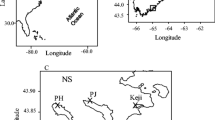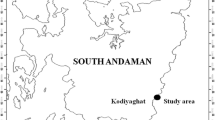Abstract
Assemblages of small, motile invertebrates (epifauna) from eelgrass(Zostera muelleri) and unvegetated habitats in a shallow, marine-dominatedestuary were compared at five sampling periods over one year. Assemblagesbased on abundance and biomass of 21 taxa from the two habitats groupedseparately in multivariate analyses (MDS ordination), and these groupingswere shown to be significant using an analysis of similarities (ANOSIM)randomisation routine. Secondarily to habitat differences, weak influencesof water temperature and distance to open water, but not of salinity, weredetected at some periods. Abundance and biomass of key taxa and all speciescombined were higha in eelgrass than in unvegetated habitat. Cumaceans wereexceptional in being collected predominantly from unvegetated habitat. Totalepifaunal production and crustacean production estimated using twovariables, (1) the biomass of individuals of each size class, and (2) watertemperature, were also higher in eelgrass than in unvegetated habitat. Thehigher abundance in eelgrass of taxa such as amphipods, harpacticoidcopepods and polychaetes that are major components of the diets of smallfish is consistent with a model explaining higher fish numbers in eelgrassin terms of prey availability.
Similar content being viewed by others
References
Bell, J. D. & M. Westoby, 1986. Abundance of macrofauna in dense seagrass is due to habitat preference, not predation. Oecologia 68: 205–209.
Bell, S. S. & R. F. Hicks, 1991. Marine landscapes and faunal recruitment: a field test with seagrasses and copepods. Mar. Ecol. Prog. Ser. 73: 61–68.
Clarke, K. R., 1993. Non-parametric multivariate analyses of changes in community structure. Aust. J. Ecol. 18: 117–143.
Clarke, K. R. & M. Ainsworth, 1993. A method of linking multivariate community structure to environmental variables. Mar. Ecol. Prog. Ser. 92: 205–219.
Connolly, R. M., 1994a. A comparison of fish assemblages from seagrass and unvegetated areas of a southern Australian estuary. Aust. J. mar. Freshwat. Res. 45: 1033–1044.
Connolly, R. M., 1994b. The role of seagrass as preferred habitat for juvenile Sillaginodes punctata(Sillaginidae, Pisces): habitat selection or feeding? J. exp. mar. Biol. Ecol. 180: 39–47.
Connolly, R. M., 1994c. Removal of seagrass canopy: effects on small fish and their prey. J. exp. mar. Biol. Ecol. 184: 99–110.
Connolly, R. M., 1995a. Effects of removal of seagrass canopy on assemblages of small, motile invertebrates. Mar. Ecol. Prog. Ser. 118: 129–137.
Connolly, R. M., 1995b. Diet of juvenile King George whiting Sillaginodes punctata(Pisces: Sillaginidae) in the Barker Inlet–Port River estuary, South Australia. Trans. r. Soc. S. Aust. 119: 191–198.
Connolly, R. M. & A. J. Butler, 1996. Effects of altering seagrass canopy height on small, motile invertebrates of shallow Mediterranean embayments. Mar. Ecol. 17: 637–652.
Edgar, G. J., 1990a. The use of the size structure of benthic macrofaunal communities to estimate faunal biomass and secondary production. J. exp. mar. Biol. Ecol. 137: 195–214.
Edgar, G. J., 1990b. The influence of plant structure on the species richness, biomass and secondary production of macrofaunal assemblages associated with Western Australian seagrass beds. J. exp. mar. Biol. Ecol. 137: 215–240.
Edgar, G. J., 1993. Measurement of the carrying capacity of benthic habitats using a metabolic-rate based index. Oecologia 95: 115–121.
Edgar, G. J., 1994. Observations on the size-structure ofmacrofaunal assemblages. J. exp. mar. Biol. Ecol. 176: 227–243.
Edgar, G. J., C. Shaw, G. F. Watson & L. S. Hammond, 1994. Comparisons of species richness, size-structure and production of benthos in vegetated and unvegetated habitats inWestern Port, Victoria. J. exp. mar. Biol. Ecol. 176: 201–226.
Gee, J. M., 1989. An ecological and economic review of meiofauna as food for fish. Zool. J. Linn. Soc. 96: 243–261.
Howard, R. K., 1987. Diel variation in the abundance of epifauna associated with seagrasses of the Indian River, Florida, USA. Mar. Biol. 96: 137–142.
Howard, R. K., G. J. Edgar & P. A. Hutchings, 1989. Faunal assemblages of seagrass beds. In A. W. D. Larkum, A. J. McComb & S. A. Shepherd (eds), Biology of Seagrasses. Elsevier, Amsterdam: 536–564.
Klumpp, D. W., R. K. Howard & D. A. Pollard, 1989. Trophodynamics and nutritional ecology of seagrass communities. In A. W. D. Larkum, A. J. McComby & S. A. Shepherd (eds), Biology of Seagrasses. Elsevier, Amsterdam: 394–457.
Leber, K. M., 1985. The influence of predatory decapods, refuge, and microhabitat selection on seagrass communities. Ecology 66: 1951–1964.
Lewis, F. G., 1984. Distribution of macrobenthic crustaceans associated with Thalassia, Haloduleand bare sand substrata. Mar. Ecol. Prog. Ser. 19: 101–113.
Orth, R. J., K. L. Heck & J. Van Montfrans, 1984. Faunal communities in seagrass beds: a review of the influence of plant structure and prey characteristics on predator-prey relationships. Estuaries 7: 339–350.
Sergeev, V. N., S. M. Clarke & S. A. Shepherd, 1988. Motile macroepifauna of the seagrasses, Amphibolisand Posidonia, and unvegetated sandy substrata in Holdfast Bay, South Australia. Trans. r. Soc. S. Aust. 112: 97–108.
Stoner, A.W., 1980. Perception and choice of substratum by epifaunal amphipods associated with seagrasses. Mar. Ecol. Prog. Ser. 3: 105–111.
Warwick, R. M., 1988. Analysis of community attributes of the macrobenthos of Frierfjord/Langesundfjord at taxonomic levels higher than species. Mar. Ecol. Prog. Ser. 46: 167–170.
Author information
Authors and Affiliations
Rights and permissions
About this article
Cite this article
Connolly, R.M. Differences in composition of small, motile invertebrate assemblages from seagrass and unvegetated habitats in a southern Australian estuary. Hydrobiologia 346, 137–148 (1997). https://doi.org/10.1023/A:1002970100662
Issue Date:
DOI: https://doi.org/10.1023/A:1002970100662




